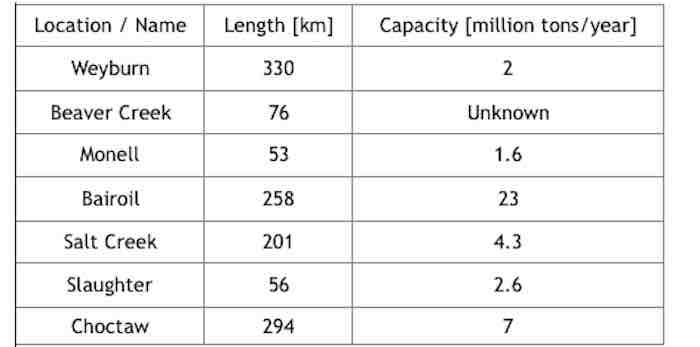Anyone who still thinks that the CO2-EOR is a simple and/or economical method to STORE "carbon" underground is mistaken
The "Carbon Capture Syndrome" (CCS) -- Part-2

The CCS needs to be examined more closely, particularly in view of a very recent paper with the title "Carbon capture and storage (CCS): the way forward," published in the journal
Energy & Environmental Science, available for free at
https://pubs.rsc.org/en/content/articlepdf/2018/ee/c7ee02342a
This 114-page report, authored by no less than 30 people from 20 or so research institutes, university departments, and companies also makes proclamations on such things as "key negative emission technologies (NETs)", "bioenergy with CCS (BECCS)," and "direct [CO2] air capture (DAC)." Lead author is Dr. Mai Bui of the
Imperial College London, UK.
The paper's abstract states,
inter alia: "Carbon capture and storage is broadly recognized as having the potential to play a key role in meeting climate change targets, delivering low carbon heat and power, decarbonizing industry and, more recently, its ability to facilitate the net removal of CO2 from the atmosphere."
A second report, entitled "CO2 Pipeline Infrastructure," published in 2014 by the IEA Environmental Projects Ltd. (IEAGHG) is another reference used here. This 147-page report is available at no cost from
Global CCS Institute's website at
https://ieaghg.org/docs/General_Docs/Reports/2013-18.pdf .
Up Front
Please let me unequivocally state here, right up front, that both articles are based on the assumption that carbon dioxide (CO2) emissions need to be curtailed, or even "reversed" (by capturing any of the existing atmospheric CO2, currently at 0.04%) in order to "save the climate."
I vehemently disagree with that notion. Therefore, this post, exploring the CCS proposal(s), does not at all imply any credence to the widely (UN-IPCC, NGOs, etc.) claimed CO2-climate connection.
The whole "CO2-climate" idea is nothing but a clever concoction designed to lead to a global (UN-led) governance, destruction of western living standards, loss of private ownership, and--in the end--destroying mankind's progress over the last millennia. In that, it's the basic idea of communism, where "the common good" is above all other considerations. Of course, the term "common good" has a vastly different meaning to the elite and everyone else.
However, since much of the western world seems to be "hell-bent" to follow the path to energy-deprivation, along with carbon-capture and storage schemes, it is necessary to look at this idea a bit more closely.
Let's start with the use of CO2 to achieve Enhanced Oil Recovery (EOR).
Enhanced Oil Recovery (EOR)
The major industrial use of CO2 is as a tertiary recovery agent to increase oil production in depleting or old oil fields. For this purpose, the CO2 gas is typically compressed at a temperature above its critical point (31 C, or 88 F) that requires a pressure in excess of 73 BAR, or 1,100 PSI. As the industrial sources, like coal, oil or natural gas fired power plants are often considerable distances from the EOR oil fields, special CO2 pipelines are required to send that pressurized gas to the required location. The following table lists a selection of operating EOR systems in North America.
Table: Operating CO2-injection EOR facilities in North America. Data selected from Table 2, CO2 pipeline projects included in the assessment, IEAGHG, "CO2 Pipeline Infrastructure", 2013/18, December, 2013; available at [url=https://ieaghg.org/docs/General_Docs/Reports/2013-18.pdf]https://ieaghg.org/docs/General_Docs/Reports/2013-18.pdf[/url] .

Actually, the original idea of using pressurized CO2 to enhance or extend oil field recovery rates dates back to 1950s or so. According to a detailed report by the
US Geological Service of 2015, it is a very effective method to increase recovery rates by up to 50% compared to conventional methods, particularly of reservoirs
below a depth of 2,000 ft.
The Reason for CO2-EOR's Existence and Effectiveness
This CO2-enhanced oil recovery relies, primarily, on one important property of CO2, namely its full miscibility with crude oil (in
supercritical state). In other words, it dissolves in the oil and thereby reduces the oil's viscosity and increases its ability to permeate through the rock cavities and rise to the surface. That effect can lead to a substantial increase in oil recovery from otherwise depleted fields. Needless to say, that's a great benefit to the producers and the world at large.
In addition, the CO2-EOR pressurizes the deep underground reservoir to increase the flow of oil.
Of course, this CO2-EOR technology was never intended as a permanent "CO2-storage" system. Nevertheless, it didn't take long for the CO2-EOR process to be touted as a poster child for the (supposedly) successful "carbon capture and storage method." No wonder some anti-carbon folks think that the reason for the CO2-EOR's existence to begin with was to sequester carbon." In reality, that's a false claim.
Let's look at just one example, the Weyburn project that has been studied for nearly two decades now.
The Weyburn CO2-EOR Site
The Weyburn oil-field is located in the Province of Saskatchewan, near the border with Manitoba, Montana, and North Dakota. The oil-bearing horizon is located in the entire region and even stretches south into South Dakota. As there is a detailed report available on "The Weyburn CO2 Injection Project" (WIP), it may serve here as an example. It is described in the 2012 book "
Microseismic Monitoring and Geomechanical Modelling of CO2 Storage in Subsurface Reservoirs" by JP Verdon.
The WIP was selected as the location for a major research project by the
Canadian Petroleum Technology Research Center (PTRC) in collaboration with the field operators and other groups, back in the year 2000 to study the effect
of CO2 injection as a method to enhance oil recovery.
The Weyburn site is solely "a commercial-scale,
CO2-injection enhanced oil recovery (CO2-EOR) site in Canada. More than a decade of research at the WIP site has led to an extensive collection of site characterization data, a situation that is unlikely to be true for many other Geological Carbon Storage (GCS) projects around the world."
CO2-EOR is NOT a "Carbon-Storage System"
Even the "
Energy Justice Network" says so and a 2010 report by the
Massachusetts Institute of Technology, titled "
Role of Enhanced Oil Recovery in Accelerating the Deployment of Carbon Capture and Sequestration" also points out the clear differentiation in the US tax code between CO2-EOR and CO2 injection for carbon storage.
Wikipedia states "It is estimated that the [WIP] EOR project will store around 20 million tons of carbon dioxide, generate about 130 million barrels of oil, and extend the life of the field by over two decades."
Clearly, any notion of "carbon storage" was, at best, an afterthought. There is much more to the CO2-EOR enhanced oil recovery system than meets the eye, namely the final fate of that injected CO2.
Where does the CO2 finally end up?
As mentioned above, the oil in the deep underground and the high-pressure CO2 will mix or dissolve freely in each other. So, all the CO2-EOR oil contains much CO2 that once it gets to the surface--surprise (??)--is not necessarily "re-injected" into the (oil) reservoir but released to the atmosphere. The reason is that such a "secondary injection" would wipe out a great part of the cost advantage of the whole CO2-EOR system. Estimates of the amount of the previously injected CO2 so re-emitted to the atmosphere are as high as 75%.
In some CO2-EOR cases like in the Permian basin, the CO2 is re-captured and re-injected. However this requires additional on-(drill)-site technology and compression energy that consumes approximately 50% of the additional oil produced.
Clearly, any honest cost-benefit analysis must consider all factors, not just those based on a perceived temporary advantage, political expediency, or mistaken beliefs.
On the CCS-Economics
Already the CO2-EOR is highly dependent on a variety of (rapidly) changing economics. A major factor, of course, is the price of crude oil, e.g.
Western Texas Intermediate that is the benchmark for the North American market. In addition, the large scale availability of steady and massive amounts of highly compressed CO2 at the injection site is a major consideration at each site. It requires, almost universally, specialized pipelines that are more costly to build and maintain than other pipelines (for CO2-related reasons).
As a result, the economic benefit of the CO2-EOR process is variable and highly dependent on external factors and market conditions.
The Take-Aways
- Anyone who still thinks that the CO2-EOR is a simple and/or economical method to STORE "carbon" underground is mistaken. It is nothing of that sort.
- Anyone who thinks that any carbon capture and long-term underground CO2 storage would be a "free ride" to solve a non-existing "climate-malady" ought to learn the ecological-, energy-, and economic costs of such and rethink the idea.
Dr. Klaus L.E. Kaiser -- Bio and
Archives |
Comments
Dr. Klaus L.E. Kaiser is author of CONVENIENT MYTHS, the green revolution – perceptions, politics, and facts Convenient Myths

 The CCS needs to be examined more closely, particularly in view of a very recent paper with the title "Carbon capture and storage (CCS): the way forward," published in the journal Energy & Environmental Science, available for free at https://pubs.rsc.org/en/content/articlepdf/2018/ee/c7ee02342a
This 114-page report, authored by no less than 30 people from 20 or so research institutes, university departments, and companies also makes proclamations on such things as "key negative emission technologies (NETs)", "bioenergy with CCS (BECCS)," and "direct [CO2] air capture (DAC)." Lead author is Dr. Mai Bui of the Imperial College London, UK.
The CCS needs to be examined more closely, particularly in view of a very recent paper with the title "Carbon capture and storage (CCS): the way forward," published in the journal Energy & Environmental Science, available for free at https://pubs.rsc.org/en/content/articlepdf/2018/ee/c7ee02342a
This 114-page report, authored by no less than 30 people from 20 or so research institutes, university departments, and companies also makes proclamations on such things as "key negative emission technologies (NETs)", "bioenergy with CCS (BECCS)," and "direct [CO2] air capture (DAC)." Lead author is Dr. Mai Bui of the Imperial College London, UK. Actually, the original idea of using pressurized CO2 to enhance or extend oil field recovery rates dates back to 1950s or so. According to a detailed report by the US Geological Service of 2015, it is a very effective method to increase recovery rates by up to 50% compared to conventional methods, particularly of reservoirs below a depth of 2,000 ft.
Actually, the original idea of using pressurized CO2 to enhance or extend oil field recovery rates dates back to 1950s or so. According to a detailed report by the US Geological Service of 2015, it is a very effective method to increase recovery rates by up to 50% compared to conventional methods, particularly of reservoirs below a depth of 2,000 ft.